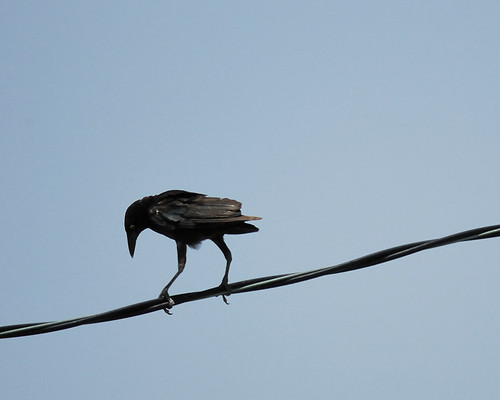tags: Great-tailed Grackle, Quiscalus mexicanus, birds, mystery bird, bird ID quiz
[Mystery bird] Great-tailed Grackle, Quiscalus mexicanus, photographed at Bolivar Flats, Texas. [I will identify this bird for you in 48 hours]
Image: Joseph Kennedy, 14 July 2009 [larger view].
Nikon D200, Kowa 883 telescope with TSN-PZ camera eyepiece 1/1000s f/8.0 at 1000.0mm iso400.
Please name at least one field mark that supports your identification.
- Log in to post comments
More like this
tags: Cooper's Hawk, Chicken Hawk, Blue Darter, Accipiter cooperii, birds, mystery bird, bird ID quiz
[Mystery bird] Sharp-shinned Hawk, Accipiter striatus, Cooper's Hawk, also known as a Chicken Hawk or Blue Darter (?!), Accipiter cooperii, photographed at Smith Point, Texas. [I will identify…
tags: Ross's Goose, Chen rossii, birds, mystery bird, bird ID quiz
[Mystery bird] Ross's Goose, Chen rossii, photographed at Tom Bass Park, Texas. [I will identify this bird for you in 48 hours]
Image: Joseph Kennedy, 11 August 2009 [larger view].
Nikon D200, Kowa 883 telescope with TSN-PZ…
tags: Yellow-crowned Night-heron, Nycticorax violaceus, birds, mystery bird, bird ID quiz
[Mystery bird] Yellow-crowned Night-heron, Nycticorax violaceus, photographed at Bolivar Flats, Texas. [I will identify this bird for you in 48 hours]
Image: Joseph Kennedy, 24 July 2009 [larger view].…
tags: birds, mystery bird, bird ID quiz
[Mystery bird #1] Ring-necked Duck, Aythya collaris, photographed at the Hermann Park Conservancy, Houston, Texas. [I will identify this bird for you in 48 hours]
Image: Joseph Kennedy, 18 November 2009 [larger view].
Nikon D200, Kowa 883 telescope with…


I'm going to guess that that's a male great-tailed grackle undergoing its tail molt. I'm saying "grackle" because, except for the missing tail, the plumage and silhouette seem gracklish. The hint of blue-ish (purplish?) iridescence that I think I'm seeing on the wing tells me it's the male, and probably not a common grackle, and the yellow iris tells me it's probably not the boat-tailed, which Sibley describes as having a brown eye in adult Gulf Coast males.
There are a lot of limbs I'm climbing out on to get to the ID, so it won't shock me to find out that I'm completely wrong. But that's what I'm putting my chips on.
Looks to me like a grackle-y type bird, but without its tail.
Not that I know anything about American birds.
I saw about 20 just like him yesterday- Great Tailed Grackle.
I don't see Great-tailed Grackles very often, but I'm fairly confident this is one. The long legs are a perfect match--much longer than a Common Grackle's legs, both in actuality & in proportion. I do see tail-less Common Grackles with some frequency (especially after the breeding season) and can certainly believe Great-tailed Grackles also lose their tail feathers. Ignoring the lack of long tail, this bird looks like a perfect match for a male Great-tailed Grackle, as stated by others above. The iridescence looks to be the right color pattern (i.e. not the dramatic contrast of the head with the rest of the body, as seen on the Common Grackle), the bird has a pale eye (so not a Boat-tailed Grackle), and the bill is far too large & heavy to be a Brewer's Blackbird.
At least to me, the beak looks too prominent and the body to heavy for a grackle. Also, the bird does not apppear to have a pale iris. Just to be exotic, I'm going with Fish Crow on the southern in of its range on the Texas. However, I'm not sure it's possible to distinguish the Fish Crow from the American Crow without hearing the bird.
scott: take a closer look at that beak, and compare with crows and grackles. i think the beak looks very un-crow-like.
I'm no ornithologist but I'm surrounded here by flocks of Great-Tailed Grackles. All the vehicles in our lot at work are about 50% paint and chrome and 50% "grackle spackle".
I asked my Texas native friends why so many male grackles wind up missing their tail feathers. No one knew, so I'm trying to find out. Anyone know for sure? Thanks for your time!